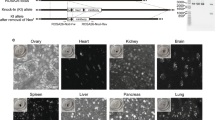Abstract
LEC10 is a dominant glycosylation mutant of Chinese hamster ovary (CHO) cells that expresses a developmentally regulated glycosyltransferase (GlcNAc-TIII) not detectable in parental CHO cells. Several mutagens were found to increase the frequency of LEC10 mutants up to 10-fold over the spontaneous frequency of ≤10−7, while 5azaC treatment had no effect. Revenants were obtained at high frequency (∼10−4) and were found to belong to two classes. Three independent revertants gave rise to new LEC10 mutants at high frequency (∼10−4) while seven others gave new LEC10 mutants at the low frequency typical of unmutagenized parental CHO cells. No evidence of a general mutator phenotype was found in the revenant lines with a high rereversion frequency. The combined data suggest a novel form of genomic instability at the LEC10 locus in CHO cells. Genetic events that affect the expression of developmentally regulated glycosyltransferases may be identified by further studies of LEC10 and other dominant CHO glycosylation mutants.
Similar content being viewed by others
Literature cited
Feizi, T. (1985).Nature 314:53–57.
Hakomori, S.I. (1985).Cancer Res. 45:2405–2414.
Stanley, P. (1984).Annu. Rev. Genet. 18:525–552.
Stanley, P. (1987).Trends Genet. 3:77–81.
Campbell, C., and Stanley, P. (1984).J. Biol. Chem. 261:13370–13378.
Narasimhan, S. (1982).J. Biol. Chem. 257:10235–10242.
Narasimhan, S., Lee, J.W.W., Cheung, R.K., Gelfand, E.W., and Schachter, H. (1988).Biochem. Cell Biol. 66:889–900.
Yoshima, H., Shiraishi, N., Matsumoto, A., Maeda, S., Sugiyama, T., and Kobata, A. (1982).J. Biochem. (Tokyo) 91:233–246.
Narasimhan, S., Schachter, H., and Rajalakshmi, S. (1988).J. Biol. Chem. 263:1273–1281.
Spooncer, E., Fukuda, M., Klock, J.C., Oates, J.E., and Dell, A. (1984).J. Biol. Chem. 259:4792–4801.
Mizoguchi, A., Maeda, S., Shiraishi, N., Yoshima, H., and Sugiyama, T. (1986).Cancer Res. 46:29–37.
Mizoguchi, A., Takasaki, S., Maeda, S., and Kobata, A. (1984).J. Biol. Chem. 259:11943–11948.
Stanley, P., Caillibot, V., and Siminovitch, L. (1975).Cell 6:121–128.
McGarrity, G., Sarama, J., and Vanaman, V. (1979).In Vitro 15:73–81.
Stanley, P. (1983).Methods Enzymol. 96:157–184.
Lea, D.E., and Coulson, C.A. (1949).J. Genet. 49:264–285.
Townsend, R.R., Hilliker, E., Li, Y., Laine, R.A., Bell, W.R., and Lee, Y.C. (1982).J. Biol. Chem. 257:9704–9710.
Stanley, P. (1982)Arch. Biochem. Biophys. 219:128–139.
Markwell, M.A.K., Haas, M., Bieber, L.L., and Tolbert, N.E. (1978)Anal. Biochem. 87:206–210.
Stanley, P., Caillibot, V., and Siminovitch, L. (1975).Somat. Cell Genet. 1:3–26.
Hince, T.A., and Neale, S. (1974).Mutat. Res. 24:383–387.
Chaney, W., and Stanley, P. (1986).J. Biol. Chem. 261:10551–10557.
Luria, S.E., and Delbruck, M. (1943).Genetics 28:491–511.
Meuth, M., L'Heureux-Huard, N., and Trudel, M. (1979).Proc. Natl. Acad. Sci. U.S.A. 12:6505–6509.
Kelsall, A., and Meuth, M. (1988).Somat. Cell Mol. Genet. 14:149–154.
Harris, M. (1984).Somat. Cell Mol. Genet. 10:615–624.
Jeggo, P.A., and Holliday, R. (1986).Mol. Cell Biol. 6:2944–2949.
Harris, M. (1986).Somat. Cell Mol. Genet. 12:459–466.
Gottesman, M.M. (ed.). (1985).Molecular Cell Genetics (John Wiley & Sons, New York).
Gupta, R.S., and Siminovitch, L. (1978).Somat. Cell Genet. 4:715–735.
Roeder, S.G., Farabaugh, P.J., Chaleff, D.T., and Fink, G.R. (1980).Science 209:1375–1380.
Engels, W.R. (1989). InMobile DNA, (ed.) Berg, E.D. and Howe, M.M. (in press).
French, D.L., Laskov, R., and Scharff, M.D. (1989)Science 244:1152–1157.
Herskowitz, I., and Oshima, Y. (1981). InThe Molecular Biology of the Yeast Saccharomyces cerevisiae:Life Cycle and Inheritance. (eds.) Strathern, J.N., Jones, W.W., and Broach, J.R. (Cold Spring Harbor Laboratory, Cold Spring Harbor, New York) pp. 181–210.
Campbell, C., and Stanley, P. (1983).Cell 35:303–309.
Howard, D.R., Fukuda, M., Fukuda, M.N., and Stanley, P. (1987).J. Biol. Chem. 262:16830–16837.
Author information
Authors and Affiliations
Rights and permissions
About this article
Cite this article
Sallustio, S., Stanley, P. Novel genetic instability associated with a developmental regulated glycosyltransferase locus in Chinese hamster ovary cells. Somat Cell Mol Genet 15, 387–400 (1989). https://doi.org/10.1007/BF01534890
Received:
Revised:
Issue Date:
DOI: https://doi.org/10.1007/BF01534890




